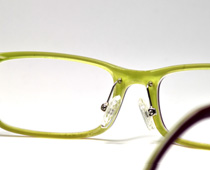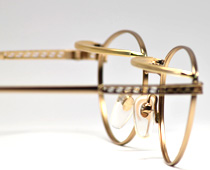Watch Us in Action Repairing Glasses in the Lab
Modification of Eyeglasses and Sunglasses
Nose Pad Arm Inserts
Cable Temple Tips
Eye Crutches: Ptosis-Crutch
The Extension of Temples on Eyewear
Electro-Plating
Lenses and Coatings
Modification of Eyeglasses and Sunglasses
Even though there are some common repairs, every repair is unique to its given elements which include the material, engineering and cause. Below you will find several different types and methods of repairs and modifications followed by a brief explanation associated with the methods and eyeglasses that are predominantly used.

Nose Pad Arms Inserts
Nose pads arm inserts, also known as Racker arms, accommodate patients that need help to support plastic frames in a comfortable position. Nose pad arms installed on plastic frames also help patients with low or no nose bridges. Oakley created a brand extension with certain plastic frames that include adjustable nose pad arms, which are referred to as "Asian Fit". There are two different techniques used to apply the nose pad inserts: Fused and pressure (see descriptions below). Both....
Read more
Cable Temple Tips
Fusing is most commonly referenced to plastic frames. Fumelting sing literally refers to combing or joining two pieces by together. Early on repairs requiring fusing were done by heating the metal hinge, brace etcetera with a torch and then fusing it into the desired
Read more
Eye Crutches: Ptosis-Crutch
The eye-crutch is also known as the Ptosis crutch because of its direct reference to the cause of the need for the crutch (Ptosis: drooping eye syndrome). Most often a standard measurement is between 10 to 15mm, but extended length may be addressed for deeper pitted eye...
Read more
The Extension of Temples on Eyewear
Temple extensions are applied to lengthen temples to virtually any desired length. Contacting manufactures to see if a longer temple size is available for the respective frame is always advised prior to extending temples. Some frames may be extended flawlessly, mainly temples with...
Read more